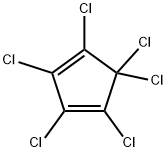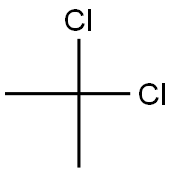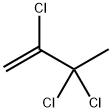Hexachlorocyclopentadiene
- CAS NO.:77-47-4
- Empirical Formula: C5Cl6
- Molecular Weight: 272.77
- MDL number: MFCD00001352
- EINECS: 201-029-3
- SAFETY DATA SHEET (SDS)
- Update Date: 2025-01-06 13:21:43

What is Hexachlorocyclopentadiene?
Description
Hexachlorocyclopentadiene is a pale-yellow/lemon-yellow liquid with a characteristic musty or pungent odour (odour threshold – 0.03 ppm). Hexachlorocyclopentadiene does not occur naturally but is a manufactured chemical. It easily evaporates into the air. Hexachlorocyclopentadiene is the key intermediate in the manufacture of some pesticides, including heptachlor, chlordane, aldrin, dieldrin, and endrin. Hexachlorocyclopentadiene is also used in the manufacture of flame retardants and some resins, shock-proof plastics, fluorocarbons, and dyes. Hexachlorocyclopentadiene quickly breaks down by sunlight and reacts with other chemicals in the air.
Chemical properties
Hexachlorocyclopentadiene is a pale-yellow to amber-colored, oily liquid. Pungent, unpleasant odor. The odor threshold is 0.15 0.33 ppm. Insoluble in water, soluble in ether, carbon tetrachloride and other organic solvents.
The Uses of Hexachlorocyclopentadiene
Hexachlorocyclopentadiene is an organochlorine compound that is used to manufacturing organochlorine insecticides and acaricides, such as mirex, aldrin, dieldrin, chlordane, endosulfan, etc. It is also used to make flame retardants, resins that won't burn, shock-proof plastics, esters, ketones, fluorocarbons, and dyes.
What are the applications of Application
Hexachlorocyclopentadiene(Hex) is an Intermediate in the manufacture of chlorinated pesticides and flame retardants. The principal end use for Hex is as a key intermediate in the production of chlorinated cyclodiene pesticides, including aldrin, dieldrin, endrin, chlordane, heptachlor, kepone, endosulfan, pentac, isodrin, and mirex. It is also used as an intermediate in the manufacture of flame retardants such as Dechlorane Plus and chlorendic anhydride and, to a lesser extent, in the manufacture of nonflammable resins, polyester resins, pharmaceuticals, unbreakable plastics, acids, esters, ketones, fluorocarbons, and dyes.
Preparation
Hexachlorocyclopentadiene is obtained by chlorination of cyclopentadiene in two steps. In addition, using petroleum pentane as raw material, hexachlorocyclopentadiene is synthesized by photochlorination and high temperature chlorination, and the yield is about 70%.
General Description
A pale yellow liquid with a pungent odor. Density 14.3 lb /gal. Solidifies at 50°F. Insoluble in water. Noncombustible. Very toxic by skin absorption and inhalation. Corrosive to tissue.
Air & Water Reactions
Insoluble in water. Reacts slowly with water to form hydrochloric acid.
Reactivity Profile
Hexachlorocyclopentadiene is incompatible with strong oxidizing and reducing agents. Also incompatible with many amines, nitrides, azo/diazo compounds, alkali metals (sodium), and epoxides.
Health Hazard
Hexachlorocyclopentadiene is very toxic and may be fatal if inhaled, swallowed, or absorbed through the skin. The probable human lethal dose is 50-500 mg/kg, or between 1 teaspoon and 1 ounce for a 150 lb. (70 kg) person. Severe exposure induces pulmonary hyperemia and edema, degenerative and necrotic changes in brain, heart and adrenal glands and necrosis of liver and kidney tubules. Questionable carcinogen.
Fire Hazard
Toxic hydrogen chloride, chlorine, and phosgene gases may form in fires. In presence of moisture, will corrode iron and other materials; flammable and explosive hydrogen gas may collect in enclosed space. Will corrode iron and other metals in the presence of moisture. Reacts slowly with water to form hydrochloric acid; however, the reaction is not hazardous. Hazardous polymerization may not occur.
Safety
Hexachlorocyclopentadiene is a manufactured chemical that does not occur naturally. Hex has no end uses of its own, and is very toxic following acute (short-term) oral and inhalation exposures. It easily evaporates into the air; the vapor looks like a blue haze. Most of the Hexachlorocyclopentadiene in the environment results from its release during production and disposal. Animal tests suggest that very high levels can cause death. Human data are limited, but it can cause headaches and irritate the nose, throat, eye, and skin.
Potential Exposure
Hexachlorocyclopentadiene is used to produce the flame retardant chlorendic anhydride, which has applications in polyesters; and to produce chlorendic anhydride and chlorendic acid; which is used as a flame retardant in resins. Hexachlorocyclopentadiene is also used as an intermediate in the production of pesticides, such as aldrin, dieldrin, and endosulfan.
First aid
If this chemical gets into the eyes, remove any con-tact lenses at once and irrigate immediately for at least 15 min,occasionally lifting upper and lower lids. Seek medical atten-tion immediately. If this chemical contacts the skin, removecontaminated clothing and wash immediately with soap andwater. Speed in removing material from the skin is of extremeimportance. Seek medical attention immediately. If this chem-ical has been inhaled, remove from exposure, begin rescuebreathing (using universal precautions, including resuscitationmask) if breathing has stopped and CPR if heart action hasstopped. Transfer promptly to a medical facility. When thischemical has been swallowed, get medical attention. Givelarge quantities of water and induce vomiting. Do not make anunconscious person vomit. Keep victim quiet and maintainnormalbody temperature. Medical observation is recom-mended for 24- 48 h after breathing overexposure, as pulmo-nary edema may be delayed. As first aid for pulmonaryedema, a doctor or authorized paramedic may consider admin-istering a corticosteroid spray.
Environmental Fate
Biological. When hexachlorocyclopentadiene (5 and 10 mg/L) was statically incubated in the
dark at 25 °C with yeast extract and settled domestic wastewater inoculum for 7 d, 100%
biodegradation with rapid adaptation was observed (Tabak et al., 1981). In a model ecosystem
containing plankton, Daphnia magna, mosquito larva (Culex pipiens quinquefasciatus), fish
(Cambusia affinis), alga (Oedogonium cardiacum), and snail (Physa sp.), hexachlorocyclopentadiene
degraded slightly, but no products were identified (Lu et al., 1975).
Photolytic. The major photolysis and hydrolysis products identified in distilled water were
pentachlorocyclopentenone and hexachlorocyclopentenone. In mineralized water, the products
identified include cis- and trans-pentachlorobutadiene, tetrachlorobutenyne, and pentachloropentadienoic
acid (Chou and Griffin, 1983). In a similar experiment, irradiation of hexachlorocyclopentadiene
in water by mercury-vapor lamps resulted in the formation of 2,3,4,4,5-
pentachloro-2-cyclopentenone. This compound hydrolyzed partially to hexachloroindenone (Butz
et al., 1982). Other photodegradation products identified include hexachloro-2-cyclopentenone and
hexachloro-3-cyclopentenone as major products. Secondary photodegradation products reported
include pentachloro-cis-2,4-pentadienoic acid, Z- and E-pentachlorobutadiene, and tetrachlorobutyne
(Chou et al., 1987). In natural surface waters, direct photolysis of hexachlorobutadiene via
sunlight results in a half-life of 10.7 min (Wolfe et al., 1982).
Chemical/Physical. Slowly reacts with water forming HCl and 1,1-dihydroxytetrachlorocyclopentadiene
(Kollig, 1993; NIOSH, 1997). The diene is unstable forming polymers (Kollig, 1993).
Solubility in organics
Based on structurally similar compounds, hexachlorocyclopentadiene is expected to be soluble in benzene, ethanol, chloroform, methylene chloride, trichloroethylene, and other liquid halogenated solvents.
storage
Color Code- -Blue: Health Hazard/Poison: Storein a secure poison location. Prior to working with thischemical you should be trained on its proper handling andstorage. Store in tightly closed containers in a cool, well-venti latedarea away from water. Protect containers fromphysical damage. In the presence of moisture, hexachloro-cyclopentadiene will corrode iron and other metals.
Shipping
UN2646 Hexachlorocyclopentadiene, Hazard Class: 6.1; Labels: 6.1-Poison Inhalation Hazard, Inhalation Hazard Zone B.
Purification Methods
Dry the diene with MgSO4, filter, and distil it under vacuum in a nitrogen atmosphere. Irritates skin and eyes, HIGHLY TOXIC. [McBee et al. J Am Chem Soc 77 4378 1955, UV spectra: Idol et al. J Org Chem 20 1746 1955, Beilstein 5 III 308, 5 IV 381.]
Toxicity evaluation
Hex’s mechanism of toxicity is incompletely understood. Because of its characteristics as a chlorinated hydrocarbon, it would be expected to induce drug-metabolizing enzymes in the liver.
Incompatibilities
Reacts slowly with water to form hydro chloric acid; will corrode iron and most metals in presence of moisture. Explosive hydrogen gas may collect in enclosed spaces in the presence of moisture. Contact with sodium may be explosive.
Waste Disposal
Incineration after mixing with another combustible fuel. Care must be exercised to assure complete combustion to prevent the formation of phosgene. An acid scrubber is necessary to remove the halo acids pro duced. Consult with environmental regulatory agencies for guidance on acceptable disposal practices. Generators of waste containing this contaminant (≥100 kg/mo) must con form to EPA regulations governing storage, transportation, treatment, and waste disposal.
Properties of Hexachlorocyclopentadiene
| Melting point: | −10 °C(lit.) |
| Boiling point: | 239 °C753 mm Hg(lit.) |
| Density | 1.702 g/mL at 25 °C(lit.) |
| vapor pressure | 0.13 psi ( 20 °C) |
| refractive index | n |
| Flash point: | 109 °C |
| storage temp. | 2-8°C |
| solubility | Chloroform (Sparingly), Ethyl Acetate (Slightly) |
| form | Yellow to amber-colored
liquid |
| color | Colourless to Pale Yellow |
| Water Solubility | 805ug/L(22.5 ºC) |
| Henry's Law Constant | 1.64(x 10-2 atm?m3/mol) at 25 °C (gas stripping-GC, Warner et al., 1987)
1.6(x 10-2 atm?m3/mol) (Pankow and Rosen, 1988) |
| Exposure limits | NIOSH REL: 10 ppb (100 mg/m3); ACGIH TLV: TWA 0.01 ppm (adopted),
0.002 mg/m3 ppm (skin). |
| Dielectric constant | 2.9100000000000001 |
| Stability: | Stability Stable, but light-sensitive. Non-flammable. Very reactive with alkenes and polynuclear hydrocarbons. Explosive with sodium. Incompatible with strong oxidizing agents, most common metals. |
| CAS DataBase Reference | 77-47-4(CAS DataBase Reference) |
| NIST Chemistry Reference | 1,3-Cyclopentadiene, 1,2,3,4,5,5-hexachloro-(77-47-4) |
| EPA Substance Registry System | Hexachlorocyclopentadiene (77-47-4) |
Safety information for Hexachlorocyclopentadiene
| Signal word | Danger |
| Pictogram(s) |
 Corrosion Corrosives GHS05  Skull and Crossbones Acute Toxicity GHS06  Environment GHS09 |
| GHS Hazard Statements |
H302:Acute toxicity,oral H311:Acute toxicity,dermal H314:Skin corrosion/irritation H330:Acute toxicity,inhalation H410:Hazardous to the aquatic environment, long-term hazard |
| Precautionary Statement Codes |
P260:Do not breathe dust/fume/gas/mist/vapours/spray. P273:Avoid release to the environment. P280:Wear protective gloves/protective clothing/eye protection/face protection. P284:Wear respiratory protection. P310:Immediately call a POISON CENTER or doctor/physician. P305+P351+P338:IF IN EYES: Rinse cautiously with water for several minutes. Remove contact lenses, if present and easy to do. Continuerinsing. |
Computed Descriptors for Hexachlorocyclopentadiene
New Products
2-Propanamine, 1-chloro-, hydrochloride (9CI) 3-Pyridineacetonitrile, α-hydroxy- 3-Iodophenylacetic acid 3-(hexyloxy)-4-(pyridin-3-yl)-1,2,5-thiadiazole 2-Hexyn-1-ol Dibenzo-18-crown-6 2-Hexanone, 98% Sodium molybdate dihydrate,98% 2,3-Dimethylphenol, 98% 4,4'-Oxydianiline Isoquinoline, 96% 2-Amino-4,6-difluorobenzoic acid, 95% (R)-2-Methylpyrolidine-2-carboxylic acid (De Mepro) Ramipril Sacubitril- Valsartan Boc-his(trt)-OH Fmoc-L-Glu-OtBu Boc-L-Tyr(tBu)-OH N N Dimethylformamide Dimethyl Acetal (Dmf Dma) Semi carbazide Hydrochloride 1-Ethyl-3-(3-Dimethylaminopropyl)-Carbodiimide Hydrochloride [EDC Hcl] Trans-4-Aminocyclohexanol [4tac] 2-[1-(Mercaptomethyl)Cyclopropyl]Acetic Acid 2-Chloromethyl-4-methyl-quinazolineRelated products of tetrahydrofuran








You may like
-
 Hexachlorocyclopentadiene CAS 77-47-4View Details
Hexachlorocyclopentadiene CAS 77-47-4View Details
77-47-4 -
 15761-38-3 N-Boc-L-Alanine >98%View Details
15761-38-3 N-Boc-L-Alanine >98%View Details
15761-38-3 -
 6485-34-3 Saccharin Calcium >98%View Details
6485-34-3 Saccharin Calcium >98%View Details
6485-34-3 -
 Boc-Gly-Gly-Phe-Gly-OH 187764-46-6 >98%View Details
Boc-Gly-Gly-Phe-Gly-OH 187764-46-6 >98%View Details
187764-46-6 -
 (S)-2-Methylpyrrolidine-2-carboxylic acid HCl (MePro) 1508261-86-6 >98%View Details
(S)-2-Methylpyrrolidine-2-carboxylic acid HCl (MePro) 1508261-86-6 >98%View Details
1508261-86-6 -
 Fmoc-Gly-Pro-OH >98%View Details
Fmoc-Gly-Pro-OH >98%View Details
212651-48-4 -
 18568-74-8 >98%View Details
18568-74-8 >98%View Details
18568-74-8 -
 138-41-0 P-Carboxy benzene sulfonamide >98%View Details
138-41-0 P-Carboxy benzene sulfonamide >98%View Details
138-41-0
